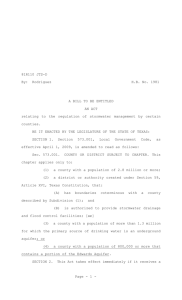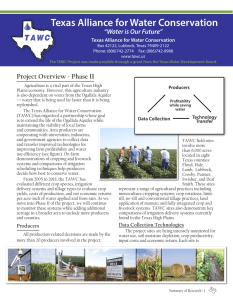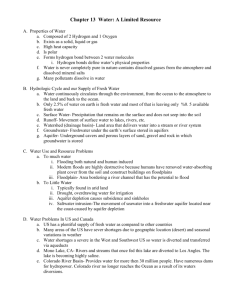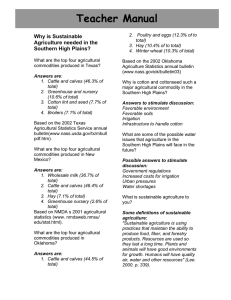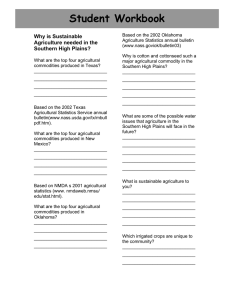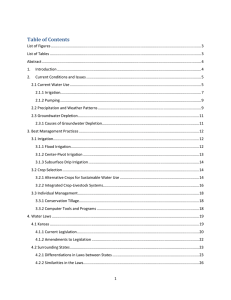The Ogallala Aquifer: Conserving the High Plains Life Source
advertisement
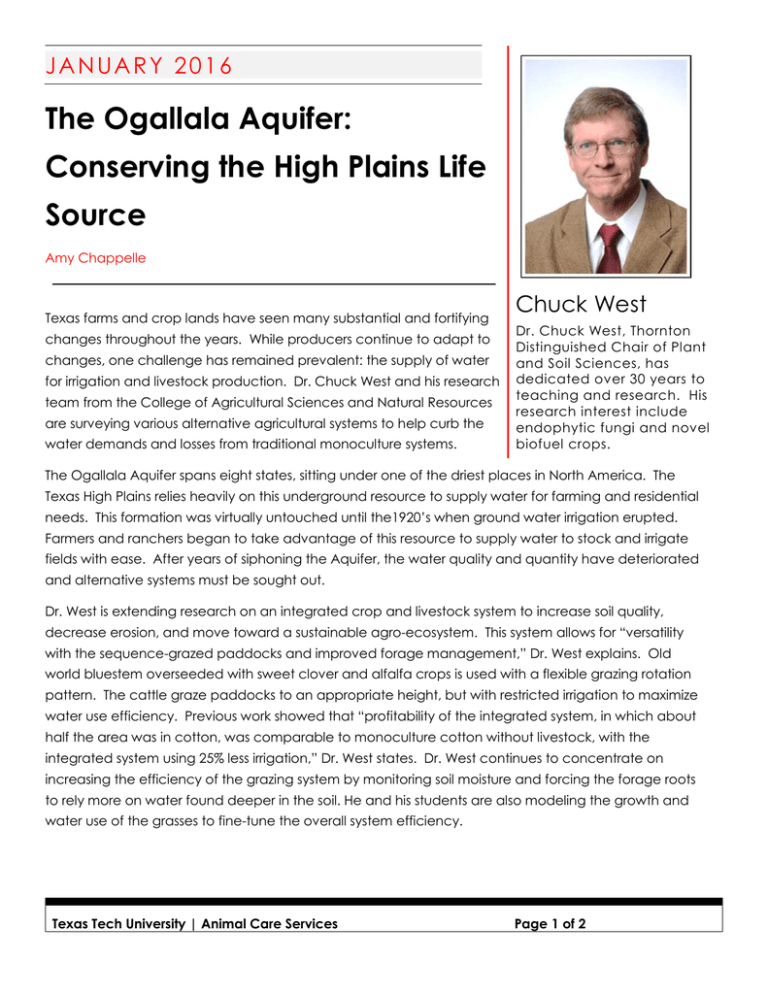
J A N UA R Y 2 0 1 6 The Ogallala Aquifer: Conserving the High Plains Life Source Amy Chappelle Texas farms and crop lands have seen many substantial and fortifying changes throughout the years. While producers continue to adapt to changes, one challenge has remained prevalent: the supply of water for irrigation and livestock production. Dr. Chuck West and his research team from the College of Agricultural Sciences and Natural Resources are surveying various alternative agricultural systems to help curb the water demands and losses from traditional monoculture systems. Chuck West Dr. Chuck West, Thornton Distinguished Chair of Plant and Soil Sciences, has dedicated over 30 years to teaching and research. His research interest include endophytic fungi and novel biofuel crops. The Ogallala Aquifer spans eight states, sitting under one of the driest places in North America. The Texas High Plains relies heavily on this underground resource to supply water for farming and residential needs. This formation was virtually untouched until the1920’s when ground water irrigation erupted. Farmers and ranchers began to take advantage of this resource to supply water to stock and irrigate fields with ease. After years of siphoning the Aquifer, the water quality and quantity have deteriorated and alternative systems must be sought out. Dr. West is extending research on an integrated crop and livestock system to increase soil quality, decrease erosion, and move toward a sustainable agro-ecosystem. This system allows for “versatility with the sequence-grazed paddocks and improved forage management,” Dr. West explains. Old world bluestem overseeded with sweet clover and alfalfa crops is used with a flexible grazing rotation pattern. The cattle graze paddocks to an appropriate height, but with restricted irrigation to maximize water use efficiency. Previous work showed that “profitability of the integrated system, in which about half the area was in cotton, was comparable to monoculture cotton without livestock, with the integrated system using 25% less irrigation,” Dr. West states. Dr. West continues to concentrate on increasing the efficiency of the grazing system by monitoring soil moisture and forcing the forage roots to rely more on water found deeper in the soil. He and his students are also modeling the growth and water use of the grasses to fine-tune the overall system efficiency. Texas Tech University | Animal Care Services Page 1 of 2 PHOTO PROVIDED COURTESTY OF LISA BAXTER The fusion of this multifaceted approach allows for careful irrigation timing so that crops make the best use of rain, while lessening the draw on the Aquifer. In addition to the positive environmental impacts, Dr. West and his research team work to reduce the burden on the rural community by decreasing overall production costs. Part of the goal of this project is to “strengthen the rural communities by ensuring the persistence of profitable agriculture in the region,” Dr. West expounds. Dr. West’s team is also testing various winter-grown cover crops to favor soil water retention, increase soil organic matter content, and decrease wind erosion. During the 1960’s and 1970’s, use of the Ogallala Aquifer increased drastically across the Texas High Plains from 1,166 to 66,000+ irrigation wells. According to USGS, in 2013, Lubbock County measured drops in water levels of 50-100 feet since 1950. To put this in perspective, that is a drop of 266.7 million acre-feet, over 86.9 trillion gallons. “This source is running dry on some farms. So the goal is to create a sustainable system through more precise management of irrigation water as a supplement to rainfall,” Dr. West validates. Progression towards an integrated agri-system is crucial to reducing the burden on the Aquifer for future generations. Dr. West communicates findings of his and others’ research to farmers and ranchers at field tours at the New Deal Research Farm and with demonstrations and conferences in the Texas Alliance for Water Conservation. The TAWC has completed 11 years of demonstrating how to use less irrigation water and reduce soil erosion, while maintaining or increasing profitability. As the population of the Texas High Plains continues to grow, education efforts likewise grow to promote irrigation efficiency. Crop and livestock producers are gradually switching to more efficient irrigation techniques than those used in the past. The life of the Ogallala Aquifer will be extended with the incorporation of precision irrigation practices and closer integration of crop and livestock production. For more information, please visit Texas Alliance for Water Conservation: www.tawc.us Texas Tech University | Animal Care Services Page 2 of 2
